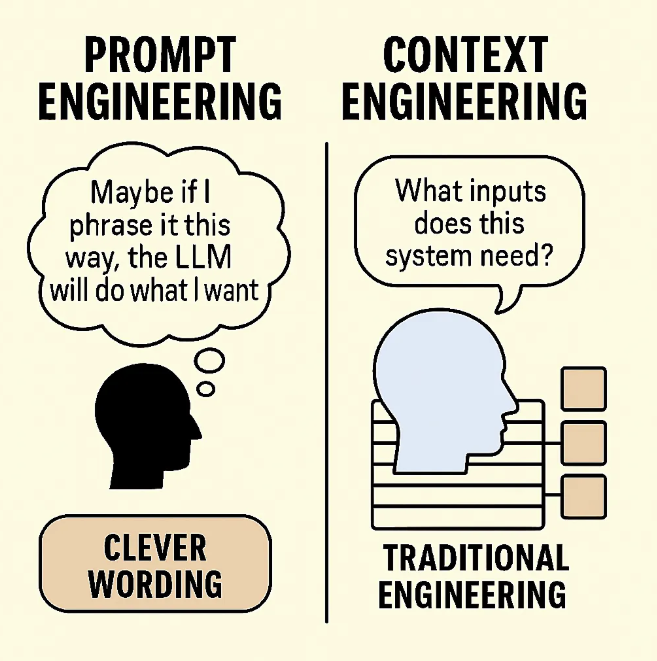In the early days of AI adoption, prompt engineering drew most of the attention. The focus was on how to craft the “right question” to get the desired answer.
Now, we’ve moved beyond that stage. Context engineering is emerging as the more critical skill—designing the environment and resources that allow the model to perform effectively, rather than simply refining sentences.
Let’s take a closer look at what this means.
From Prompt to Context
Prompt engineering is essentially the skill of asking the right question. Let’s look at two sample prompts:
“Give me a good marketing strategy.”
“I’m running a startup targeting college students, with a budget of 1 million KRW per month, and limited to online channels. Considering this situation, please create a marketing strategy.”
Clearly, the second prompt produces a far more useful answer. But even then, the model is still confined to judging only from the question itself.
This is where context engineering comes in. Rather than relying solely on the phrasing of the prompt, context engineering means designing a system that supplies the model with rich, accurate context—supporting information, tools, and surrounding data—before it generates an answer.
What is 'Context'?
No matter how well you phrase a question, an LLM can only generate answers from the information immediately available to it—often leading to fragmented judgments. Context refers to all the background information and tools that the model can consult before producing an answer.
Instructions: the model’s role, tone, and rules
User Prompt: the immediate question at hand
Conversation History (Short-term Memory): the flow of the ongoing dialogue
Long-term Memory: user preferences, past projects, stored records
Retrieved Knowledge (RAG): documents, databases, or the latest information from the web
Tools: execution functions like checking calendars or sending emails
Output Format: the desired structure of the response, such as JSON, tables, or summaries
In this sense, context isn’t just a single sentence—it’s the entire working environment set up to help the AI solve a problem. The richer the context, the more useful and accurate the model’s output will be. And with AI agents, this difference becomes even more striking.
Example
User Question: “Do I have time for a meeting tomorrow?”
With poor context:
👉🏼 “Tomorrow works. What time shall we schedule?”With rich context:
(before answering, the system pulls data from calendars, past conversations, relationships, and scheduling tools)
👉🏼 “Tomorrow is fully booked. But Thursday morning is open—I’ve already sent an invite.”
Both answers come from the same model, but the first requires extra back-and-forth, while the second delivers exactly what the user needs in a single step. The difference lies not in the model itself, but in the system providing the context.

Difference between prompt engineering and context engineering. Source: Addy Osmani.
If prompt engineering is the art of asking, “If I phrase it this way, will the LLM listen to me?”—a skill in wording things well—then context engineering answers a different question: “What information or tools should I provide to the system?” It’s less about phrasing and more about designing the system itself.

Stay ahead in AI
3 Rules of Context Engineering
1) A Systemic Approach
Context engineering isn’t about crafting the “perfect question.” It’s about designing the entire pipeline for preparing and shaping information. Imagine building an agent that schedules meetings:
First, identify the intent of the request.
Next, gather the required data (your calendar, the other person’s calendar, past conversations).
Summarize it concisely so the model can grasp it quickly.
Finally, arrange it in the right sequence and feed it to the model.
This way, the model isn’t guessing—it’s reasoning with prepared, relevant information.
2) Dynamic by Design
The context you provide depends on the type of request:
Checking schedules: calendars, contacts
Answering technical questions: documentation, wikis, latest updates
Customer support: past conversations, customer profiles
The key is selectivity. You don’t dump every piece of data into every prompt. Overloading the model with irrelevant information not only slows it down but also raises costs and risks distraction.
3) Choosing the Right Format
How you present the information can be as important as the information itself. Feeding a full block of raw text may cause the model to miss key points, whereas a short summary plus targeted excerpts helps it lock onto the right context.
The same applies to outputs: instead of saying “Just answer freely,” asking for a JSON structure or predefined fields produces results that are more consistent and easier to use. Likewise, instead of pasting verbose error logs, a concise summary highlighting root causes makes it much easier for the model to understand.
In short: it’s not only what you provide, but how you provide it that determines performance.
Practical Checklist
Clearly define the model’s role and rules
Provide summarized conversation history and store user details in long-term memory
Limit retrieval results to only the most relevant information, in concise form
Specify input/output formats for available tools, as briefly as possible
Define the desired output format so results are immediately usable
Observe which contexts are effective and continuously refine
Context engineering is like having a thoughtful, well-prepared mentor. Before handing off a task, they’ve already gathered the necessary information and selected the right platforms, then pass it on with clear instructions.
While prompt engineering and context engineering may seem different, they share one truth: outcomes depend on who uses them and how. To truly harness AI, we can’t stop at refining questions—we need to focus on designing the environment in which the model works.



